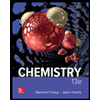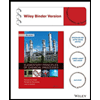
ORGANIC CHEMISTRY-STUD.SOLNS.MAN+SG(LL)
4th Edition
ISBN: 9781119659587
Author: Klein
Publisher: WILEY
expand_more
expand_more
format_list_bulleted
Question
Chapter 18.7, Problem 12CC
Interpretation Introduction
Interpretation:
- The structure of products formed in the reaction of ethoxy benzene with mixture of sulfuric acid and nitric acid has to be drawn.
- The mechanism for the formation of the major product by the same reaction has to be depicted.
Concept Introduction:
- Electrophiles are electron deficient species. In Electrophilic substitution reaction a group or atom in a compound is replaced by electrophile. This kind of reaction occurs predominantly in
aromatic compounds . Electrophilic substitution reactions of aromatic compounds are known as aromatic electrophilic substitution reactions.
- Benzene is an electron rich Aromatic compound. It undergoes aromatic electrophilic substitution reaction.
- The delocalized nature of pi electrons in benzene attributes a special property to benzene called resonance.
- The carbocation formed in Benzene (arene) ring Carbon is known as arenium carbocation. It is also known as sigma complex. It is the intermediate involved in all the aromatic electrophilic substitution reactions of benzene and related compounds. It is stabilized by delocalization of pi electrons also known as resonance.
- Mixture of concentrated Nitric acid and concentrated Sulfuric acid is known as Nitrating mixture and used in nitration reaction of benzene and its related compounds.
- If the substituents on benzene Carbon are Electron rich groups they are known as activating groups. They are ortho- and para- directing groups because these groups when directly bonded to benzene Carbon increases the electron density at ortho and para positions. So they direct the incoming electrophile towards ortho and para position in electrophilic substitution reactions.
- If the substituents on benzene Carbon are Electron withdrawing groups they are known as deactivating groups. They are meta-directing groups because these groups when directly bonded to benzene Carbon decreases the electron density at ortho and para positions and so the incoming electrophile is directed towards meta position.
Expert Solution & Answer
Want to see the full answer?
Check out a sample textbook solution
Students have asked these similar questions
draw the major product formed with the listed reagents
Propose Williamson ether syntheses for the following compounds
Identify all functional groups
Chapter 18 Solutions
ORGANIC CHEMISTRY-STUD.SOLNS.MAN+SG(LL)
Ch. 18.2 - Prob. 1CCCh. 18.3 - Prob. 2CCCh. 18.3 - Prob. 3CCCh. 18.4 - Prob. 4CCCh. 18.5 - Prob. 5CCCh. 18.5 - Prob. 6CCCh. 18.5 - Prob. 7CCCh. 18.6 - Prob. 8CCCh. 18.6 - Prob. 9CCCh. 18.6 - Prob. 10CC
Ch. 18.7 - Prob. 11CCCh. 18.7 - Prob. 12CCCh. 18.8 - Prob. 13CCCh. 18.9 - Prob. 14CCCh. 18.9 - Prob. 15CCCh. 18.10 - Prob. 1LTSCh. 18.10 - Prob. 16PTSCh. 18.10 - Prob. 17ATSCh. 18.11 - Prob. 2LTSCh. 18.11 - Prob. 18PTSCh. 18.12 - Prob. 24CCCh. 18.12 - Prob. 25CCCh. 18.12 - Prob. 5LTSCh. 18.12 - Prob. 26PTSCh. 18.12 - Prob. 6LTSCh. 18.12 - Prob. 28PTSCh. 18.13 - Prob. 30CCCh. 18.13 - Prob. 31CCCh. 18.13 - Prob. 32CCCh. 18.14 - Prob. 33CCCh. 18.14 - Prob. 34CCCh. 18.15 - Prob. 7LTSCh. 18.15 - Prob. 35PTSCh. 18.15 - Prob. 36PTSCh. 18 - Prob. 38PPCh. 18 - Prob. 39PPCh. 18 - Prob. 40PPCh. 18 - Prob. 41PPCh. 18 - Prob. 42PPCh. 18 - Prob. 43PPCh. 18 - Prob. 45PPCh. 18 - Prob. 46PPCh. 18 - Prob. 47PPCh. 18 - Prob. 48PPCh. 18 - Prob. 49PPCh. 18 - Prob. 50PPCh. 18 - Prob. 51PPCh. 18 - Prob. 52PPCh. 18 - Prob. 53PPCh. 18 - Prob. 54PPCh. 18 - Prob. 55PPCh. 18 - Prob. 56PPCh. 18 - Prob. 57PPCh. 18 - Prob. 58PPCh. 18 - Prob. 59PPCh. 18 - Prob. 60PPCh. 18 - Prob. 61PPCh. 18 - Prob. 62PPCh. 18 - Prob. 63PPCh. 18 - Prob. 64PPCh. 18 - Prob. 80IPCh. 18 - Prob. 81IPCh. 18 - Prob. 82IPCh. 18 - Prob. 83IPCh. 18 - Prob. 84IPCh. 18 - Prob. 85IPCh. 18 - Prob. 86IPCh. 18 - Prob. 87IPCh. 18 - Prob. 88IPCh. 18 - Prob. 89IP
Knowledge Booster
Similar questions
- A mixture of CaCO3 and MgC2O4 of unknown mass was heated in a 0.5 L closed rigid vessel to 900 degrees C.at 400C the following reaction occurs:MgC2O4 -> MgO (s) + CO (g) + CO2 (g)At 700C a second reaction occurs: CaCO3 -> CaO (s) + CO2 (g)The solid mass in the vessel was measured to be 3.06 g at 400C and 2.03g at 900CQuestion: What is the partial pressure of CO in both temperatures? (400 and 900C), provide detailed explanation.arrow_forwardFor the following alkyne, complete the reaction sequentially (that is draw the intermediate that we can’t stop at) and then name (complete name) all 3 molecules.arrow_forwardGiven the reaction sequence below, answer the following. A. Provide the structure for A. B. Provide the structure for B (pay attention to stereochemistry). C. Provide the structure for C. D. What are the stereochemical designations for I and II (R/S)?arrow_forward
- There are 2 reactions (that you know of) to achieve the following transformation: One reaction is favored over the other because it avoids a competing reaction. A. Draw the favored reaction scheme (not the mechanism), be sure to include all necessary reagents. B. Draw the reaction scheme that is not favored and include all the possible products.arrow_forwardBoth carbocations and carbon-radicals have trigonal planar geometry. True or Falsearrow_forwardTeflon (polytetrafluoroethene) is prepared via the radial polymerization of tetrafluoroethene. What other reaction conditions (reagent, etc.) are needed to accomplish this? A. NBS, Light B. Heat, Cl2 C. Peroxide, Heat D. H2SO4, H2O, Heatarrow_forward
- Which of the following compounds can be reacted with ethene to prepare 1,1- dichlorocyclopropane? A. CCl4 B. CCl2 C. CHCl3 D. CH2Cl2arrow_forwardusing any reactions, starting with propene, propose a synthesis for the following moleculearrow_forwardFor a free radical bromination reaction, the stereochemistry of the product is easily controlled True OR Falsearrow_forward
arrow_back_ios
SEE MORE QUESTIONS
arrow_forward_ios
Recommended textbooks for you
 ChemistryChemistryISBN:9781305957404Author:Steven S. Zumdahl, Susan A. Zumdahl, Donald J. DeCostePublisher:Cengage Learning
ChemistryChemistryISBN:9781305957404Author:Steven S. Zumdahl, Susan A. Zumdahl, Donald J. DeCostePublisher:Cengage Learning ChemistryChemistryISBN:9781259911156Author:Raymond Chang Dr., Jason Overby ProfessorPublisher:McGraw-Hill Education
ChemistryChemistryISBN:9781259911156Author:Raymond Chang Dr., Jason Overby ProfessorPublisher:McGraw-Hill Education Principles of Instrumental AnalysisChemistryISBN:9781305577213Author:Douglas A. Skoog, F. James Holler, Stanley R. CrouchPublisher:Cengage Learning
Principles of Instrumental AnalysisChemistryISBN:9781305577213Author:Douglas A. Skoog, F. James Holler, Stanley R. CrouchPublisher:Cengage Learning Organic ChemistryChemistryISBN:9780078021558Author:Janice Gorzynski Smith Dr.Publisher:McGraw-Hill Education
Organic ChemistryChemistryISBN:9780078021558Author:Janice Gorzynski Smith Dr.Publisher:McGraw-Hill Education Chemistry: Principles and ReactionsChemistryISBN:9781305079373Author:William L. Masterton, Cecile N. HurleyPublisher:Cengage Learning
Chemistry: Principles and ReactionsChemistryISBN:9781305079373Author:William L. Masterton, Cecile N. HurleyPublisher:Cengage Learning Elementary Principles of Chemical Processes, Bind...ChemistryISBN:9781118431221Author:Richard M. Felder, Ronald W. Rousseau, Lisa G. BullardPublisher:WILEY
Elementary Principles of Chemical Processes, Bind...ChemistryISBN:9781118431221Author:Richard M. Felder, Ronald W. Rousseau, Lisa G. BullardPublisher:WILEY

Chemistry
Chemistry
ISBN:9781305957404
Author:Steven S. Zumdahl, Susan A. Zumdahl, Donald J. DeCoste
Publisher:Cengage Learning

Chemistry
Chemistry
ISBN:9781259911156
Author:Raymond Chang Dr., Jason Overby Professor
Publisher:McGraw-Hill Education

Principles of Instrumental Analysis
Chemistry
ISBN:9781305577213
Author:Douglas A. Skoog, F. James Holler, Stanley R. Crouch
Publisher:Cengage Learning

Organic Chemistry
Chemistry
ISBN:9780078021558
Author:Janice Gorzynski Smith Dr.
Publisher:McGraw-Hill Education

Chemistry: Principles and Reactions
Chemistry
ISBN:9781305079373
Author:William L. Masterton, Cecile N. Hurley
Publisher:Cengage Learning

Elementary Principles of Chemical Processes, Bind...
Chemistry
ISBN:9781118431221
Author:Richard M. Felder, Ronald W. Rousseau, Lisa G. Bullard
Publisher:WILEY